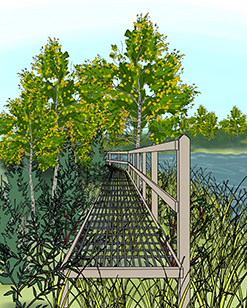
Lakes, rivers, and streams are made up of more than just the water that flows between the banks. The banks of lakes, rivers, and streams are not only crucial to the long-term health of these water systems but are beneficial to the wildlife and plant life that depends on the water systems. As Alaska's population and associated urbanization continue to increase, water systems throughout Alaska are vulnerable to the degradation of fish habitat and riparian vegetation. ADF&G works year-round to protect and restore fish habitat. ADF&G staff identify barriers that stop fish from migrating to spawning grounds and restore fish passage, remove structures such as riprap, jetties, and bulkheads that are harmful to fish, revegetate riparian corridors, and provide educational opportunities including workshops where the public can learn about fish habitat, riparian health, and how riparian corridors work.
A riparian corridor is vegetation growing near a body of water like a lake, river, or stream and continues upland as the land rises away from the river. The width of the riparian corridor is determined by size of the river, the surrounding terrain, and can vary from tens of feet to many miles, often encompassing side channels, wetlands, and oxbow lakes. Riparian corridors are more productive than the surrounding lands due to the availability of moisture and nutrients, with an abundance of vegetation and animal life. The increased productivity of the riparian area benefits fish because nutrients from the highly productive riparian corridor are the basis of the food chain in most river systems. Other functions provided by riparian corridors include moderating stream temperatures, filtering sediment and pollutants from surface runoff, slowing flood waters, buffering storm runoff, and reducing peak flows during rain events.
The removal of riparian vegetation has a negative effect on the riparian corridor. Plant roots help bond soil particles together and hold the soil in place, like rebar holding and strengthening concrete, and prevent or slow erosion of the banks during high water flows and rainstorms. In addition, vegetation adds roughness to the banks and floodplain, which slows water velocity during floods, reducing its power to erode. Slowing flows cause depositions of suspended fine sediment particles such as silt and sand in the water column on the floodplain surface thereby adding nutrients to the soil, growing, and strengthening the streambank. Human activities can cause accelerated erosion along streambanks and shorelines. These activities include the removal, cutting, or trampling of the riparian vegetation along the shorelines to access the water or fishing spots, parking and anchoring boats along banks, and by generating waves and wakes from watercraft. These are just a few of the ways human activity can alter drainage patterns from adjacent areas which then increase the intensity and frequency of runoff and cause erosion along the banks.
When a riparian corridor is impacted or eliminated there are several negative effects on streams and rivers. Flood flows increase and become more destructive as the water is not retained by wetlands or slowed by vegetation in the floodplain. Sediment and pollutants enter the river and impact water quality, fish, and other aquatic life. Fewer terrestrial insects will fall into the stream, decreasing the availability of food for fish. Also, populations of wildlife associated with riparian corridors, such as birds, bears, beavers, and otters diminish.
Illustrations by Shelly Marshall from ShellArt


